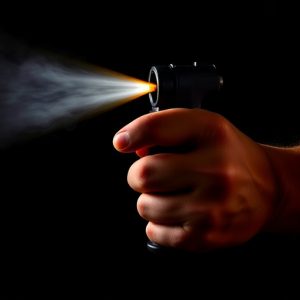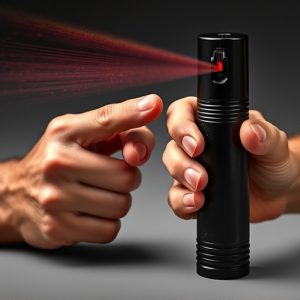Civilian Pepper Spray Defense: Effects, First Aid, Legalities, and Choices
TL;DR:Pepper spray exposure requires immediate action for safety and symptom management. Key steps i…….
TL;DR:
Pepper spray exposure requires immediate action for safety and symptom management. Key steps include:
1. Move to fresh air and a sheltered area.
2. Flush affected areas with water for at least 15 minutes to dilute and remove residue.
3. Keep eyes closed while flushing if exposed to the eyes.
4. Seek medical attention for persistent or severe symptoms, including breathing difficulties, chest pains, or loss of vision.
Understanding legal implications and staying informed about local regulations is crucial when considering civilian defense pepper spray. Proper treatment involves removing contaminated clothing, washing eyes and face, and balancing personal safety with legal adherence. Choosing the right pepper spray with high SCU values, durable design, and quick-trigger mechanisms, along with ready access to eye wash and medical care, enhances personal safety.
“Discover the power of civilian defense pepper spray, a vital tool for personal safety. This comprehensive guide explores everything you need to know about pepper spray exposure, from understanding its causes and effects to immediate response strategies. Learn essential first aid treatments and legal considerations to ensure your rights are protected.
Dive into the key features to look for when choosing the right pepper spray, enabling you to make an informed decision. Equip yourself with knowledge on how to treat pepper spray exposure effectively, giving you peace of mind and enhanced security.”
- Understanding Pepper Spray Exposure: Causes and Effects
- Immediate Steps to Take After Pepper Spray Contact
- First Aid Treatments for Pepper Spray Exposure
- Legal Considerations and Rights When Using Pepper Spray
- Choosing the Right Civilian Defense Pepper Spray: Features to Look For
Understanding Pepper Spray Exposure: Causes and Effects
Pepper spray exposure can occur in various situations, from accidental release during training to direct exposure during an attack. Understanding its causes and effects is crucial for effective treatment and prevention. Direct contact with pepper spray can irritate eyes, skin, and respiratory tract due to its active ingredient, capsaicin, which is derived from chili peppers. Inhalation of the spray can lead to coughing, difficulty breathing, and even temporary blindness.
Knowing how to treat pepper spray exposure is essential for civilians and law enforcement alike. Immediate steps include removing contaminated clothing, rinsing eyes thoroughly with water for at least 15 minutes, and seeking fresh air. Over-the-counter antihistamines and pain relievers can help manage symptoms, while medical attention should be sought for severe cases involving respiratory distress or prolonged exposure. Regular training on proper usage and handling of pepper spray products is also vital to minimize accidental exposure and ensure safe deployment in self-defense situations.
Immediate Steps to Take After Pepper Spray Contact
If you’ve been exposed to pepper spray, the first step is to move to a safe location away from the source. This could be a nearby building or area with minimal wind, as pepper spray can spread quickly and travel long distances. Remove any clothing that has come into direct contact with the spray; doing so can help prevent further irritation or absorption of the chemical.
Once in a secure spot, flush the affected areas immediately with copious amounts of clean water for at least 15 minutes. This will help to dilute and rinse away the pepper spray residue. If eye exposure occurs, it’s crucial to keep them closed as much as possible while flushing. Seek medical attention if symptoms persist or worsen, especially in cases of severe exposure. How to treat pepper spray exposure also involves staying calm and monitoring your breathing, as deep breaths can help dilute irritants in the lungs.
First Aid Treatments for Pepper Spray Exposure
Pepper spray exposure can cause significant discomfort and even severe medical issues if left untreated. Immediately after contact, flush the affected area thoroughly with plenty of water for at least 15 minutes. This helps to dilute the pepper spray and prevent it from further irritating the skin or eyes. If the exposure was eye-related, hold the affected eye open and continue flushing until any burning sensation subsides.
For skin irritation, gently wash the area with mild soap and warm water. Avoid using harsh chemicals, alcohol, or vinegar, as they can exacerbate the situation. Apply a cold compress to reduce swelling and pain. If breathing difficulties arise due to inhalation, move to a well-ventilated area and seek fresh air immediately. In severe cases characterized by difficulty breathing, chest pains, or loss of vision, emergency medical attention is crucial.
Legal Considerations and Rights When Using Pepper Spray
When considering civilian defense pepper spray, it’s crucial to understand the legal implications and rights that come with its use. Each jurisdiction has specific laws governing the possession, use, and application of pepper spray, commonly known as oleoresin capsicum (OC) spray. Users must be aware of these regulations to ensure they remain within legal boundaries. Non-compliance can result in hefty fines or even criminal charges.
Knowing how to treat pepper spray exposure is also essential. If used against you, immediate steps include removing contaminated clothing, washing eyes and face with water for at least 15 minutes, and seeking medical attention if symptoms persist. It’s important to familiarize yourself with the product’s instructions and understand when and how to deploy it responsibly, ensuring both personal safety and adherence to the law.
Choosing the Right Civilian Defense Pepper Spray: Features to Look For
Choosing the right civilian defense pepper spray is crucial, as it can mean the difference between a dangerous situation and one that’s easily manageable. When selecting a pepper spray, consider its strength – measured in SCU (spray concentration units) – with higher numbers offering greater impact but also requiring more control. A good spray should have a wide reach to allow for distance from potential attackers, and a stream or spray pattern that covers a large area to maximize effectiveness. Look for features like a durable design that can withstand outdoor conditions and a trigger mechanism designed for quick, accidental discharge prevention.
Additionally, understand how to use it properly – practice target practice to get comfortable with the range and pressure – and always carry it in an accessible location. Knowing how to treat pepper spray exposure is equally vital. Have eye wash or irrigation nearby for immediate eye flushing if splashed, and ensure proper clothing removal to prevent skin irritation. Keep a close eye on any symptoms and seek medical attention if necessary, as pepper spray can cause temporary but intense discomfort and even more severe reactions in certain individuals.
Understanding pepper spray exposure, its causes, and effects is crucial for both safety and legal awareness. Knowing immediate steps to take after contact and how to administer first aid treatments can significantly mitigate the impact of exposure. Additionally, being informed about legal considerations when using civilian defense pepper spray ensures responsible and protected use. By choosing the right product with key features, individuals can empower themselves to defend against potential threats effectively while understanding how to treat pepper spray exposure properly.


